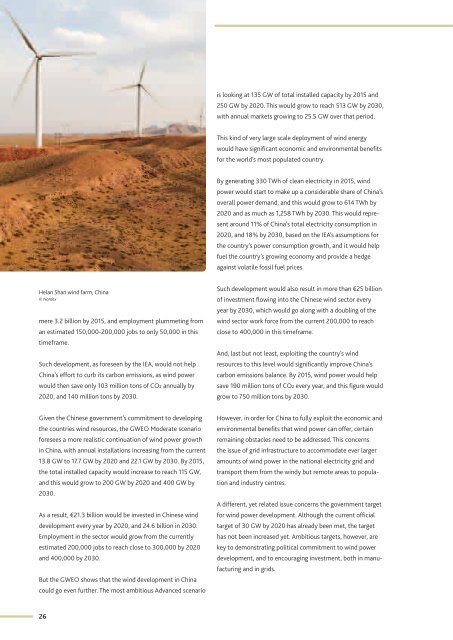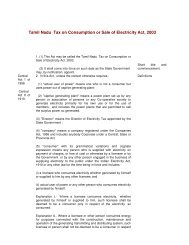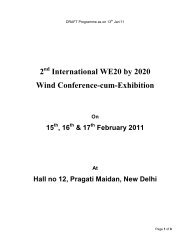glOBal Wind energy OuTlOOk 2010 - Global Wind Energy Council
glOBal Wind energy OuTlOOk 2010 - Global Wind Energy Council
glOBal Wind energy OuTlOOk 2010 - Global Wind Energy Council
Create successful ePaper yourself
Turn your PDF publications into a flip-book with our unique Google optimized e-Paper software.
is looking at 135 GW of total installed capacity by 2015 and<br />
250 GW by 2020. This would grow to reach 513 GW by 2030,<br />
with annual markets growing to 25.5 GW over that period.<br />
This kind of very large scale deployment of wind <strong>energy</strong><br />
would have significant economic and environmental benefits<br />
for the world’s most populated country.<br />
By generating 330 TWh of clean electricity in 2015, wind<br />
power would start to make up a considerable share of China’s<br />
overall power demand, and this would grow to 614 TWh by<br />
2020 and as much as 1,258 TWh by 2030. This would represent<br />
around 11% of China’s total electricity consumption in<br />
2020, and 18% by 2030, based on the IEA’s assumptions for<br />
the country’s power consumption growth, and it would help<br />
fuel the country’s growing economy and provide a hedge<br />
against volatile fossil fuel prices.<br />
Helan Shan wind farm, China<br />
© Nordex<br />
mere 3.2 billion by 2015, and employment plummeting from<br />
an estimated 150,000-200,000 jobs to only 50,000 in this<br />
timeframe.<br />
Such development, as foreseen by the IEA, would not help<br />
China’s effort to curb its carbon emissions, as wind power<br />
would then save only 103 million tons of CO2 annually by<br />
2020, and 140 million tons by 2030.<br />
Such development would also result in more than €25 billion<br />
of investment flowing into the Chinese wind sector every<br />
year by 2030, which would go along with a doubling of the<br />
wind sector work force from the current 200,000 to reach<br />
close to 400,000 in this timeframe.<br />
And, last but not least, exploiting the country’s wind<br />
resources to this level would significantly improve China’s<br />
carbon emissions balance. By 2015, wind power would help<br />
save 190 million tons of CO2 every year, and this figure would<br />
grow to 750 million tons by 2030.<br />
Given the Chinese government’s commitment to developing<br />
the countries wind resources, the GWEO Moderate scenario<br />
foresees a more realistic continuation of wind power growth<br />
in China, with annual installations increasing from the current<br />
13.8 GW to 17.7 GW by 2020 and 22.1 GW by 2030. By 2015,<br />
the total installed capacity would increase to reach 115 GW,<br />
and this would grow to 200 GW by 2020 and 400 GW by<br />
2030.<br />
As a result, €21.3 billion would be invested in Chinese wind<br />
development every year by 2020, and 24.6 billion in 2030.<br />
Employment in the sector would grow from the currently<br />
estimated 200,000 jobs to reach close to 300,000 by 2020<br />
and 400,000 by 2030.<br />
But the GWEO shows that the wind development in China<br />
could go even further. The most ambitious Advanced scenario<br />
However, in order for China to fully exploit the economic and<br />
environmental benefits that wind power can offer, certain<br />
remaining obstacles need to be addressed. This concerns<br />
the issue of grid infrastructure to accommodate ever larger<br />
amounts of wind power in the national electricity grid and<br />
transport them from the windy but remote areas to population<br />
and industry centres.<br />
A different, yet related issue concerns the government target<br />
for wind power development. Although the current official<br />
target of 30 GW by 2020 has already been met, the target<br />
has not been increased yet. Ambitious targets, however, are<br />
key to demonstrating political commitment to wind power<br />
development, and to encouraging investment, both in manufacturing<br />
and in grids.<br />
26

















